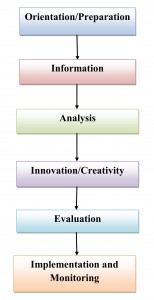4. Innovation/Creativity
For this phase it is necessary to use creative techniques that generate alternatives. Starting from the analysis of functions and costs, there is a search for means that allow elimination, change or improvement of components and functions.
It is important to look for different ways of satisfying the basic functions, even if it means rejecting the current approach and starting again with a clean drawing board. This requires the product or process to be ‘mentally destroyed’ and then rebuild a new one.
In value analysis as in method study a persistent critical examination of facts is extremely important. Creative phase objective is to produce ideas and to formulate alternative ways for accomplishing the essential functions and improving the value of the problem under consideration.
This effort starts as soon as enough information has been collected, reviewed and understood.
5. Evaluation
It represents a confrontation of ideas, a collection of information about the feasibility and cost of those ideas, and measures the value of the best alternatives.
This analysis or evaluation uses the same techniques of value measurement that have been used in previous steps. At this point an examination is done about the grade of functional accomplishment and the economical analysis of those alternatives that offer the higher value. Some of the techniques are well-known such as Cash-flow analysis and break-even point.
The team involved in Value Analysis needs an objective analysis of the ideas generated through the innovation phase. The evaluation phase is carried out in two main steps:
- A qualitative analysis of value regarding objectives in design, cost, implementation facilities, etc.
- A quantitative analysis using numerical techniques of value measurement that leads to a few alternatives of high value that will be analysed in depth.
This process usually involves determining the cost and select those ideas that can be practically implemented. This may include work to develop and refine promising ideas into practical and optimum solutions.
Objectives:
The objectives of evaluation phase are:
(i) To select for further analysis the most promising of the ideas generated during the creative phase.
(ii) To subject the ideas to a preliminary screening to identify those which satisfy the following criteria.
(iii) Will the idea work?
(iv) Is it cheaper than present design?
(v) Is it feasible to implement?
(vi) Will it satisfy the user requirements?
(vii) If the answer to any of the above is “no” car, it be modified or combined with another to give a yes answer.
(viii) To find out which is the most suitable proposal and obtain its cost?
The generation of a quantity of ideas does not accomplish anything until these ideas are put to use. Before these can be utilized continued creativity must be applied. This may be done on a single idea or a combination of ideas.
6. Implementation and Monitoring
In this phase it is necessary to prepare a report that summarizes the work that has been done, including conclusions and specific proposals. It will be also necessary to describe actions plans for implementation, in which project management techniques would be useful.
Finally a plan should be included for monitoring of the actions. This should be based in the accomplishment of objectives.
Uses of Value Engineering
1. It is a cost prevention as well as cost elimination technique thus reducing cost of product.
2. Helps employees for better understanding of their jobs and orients them towards thinking
3. Balance the cost and performance
4. Prevents over design of components.
5. Motivates employees to come out with creative ideas.
6. Increases the profits and deflates costs.
7. Helps to satisfy the customer with company’s products.


